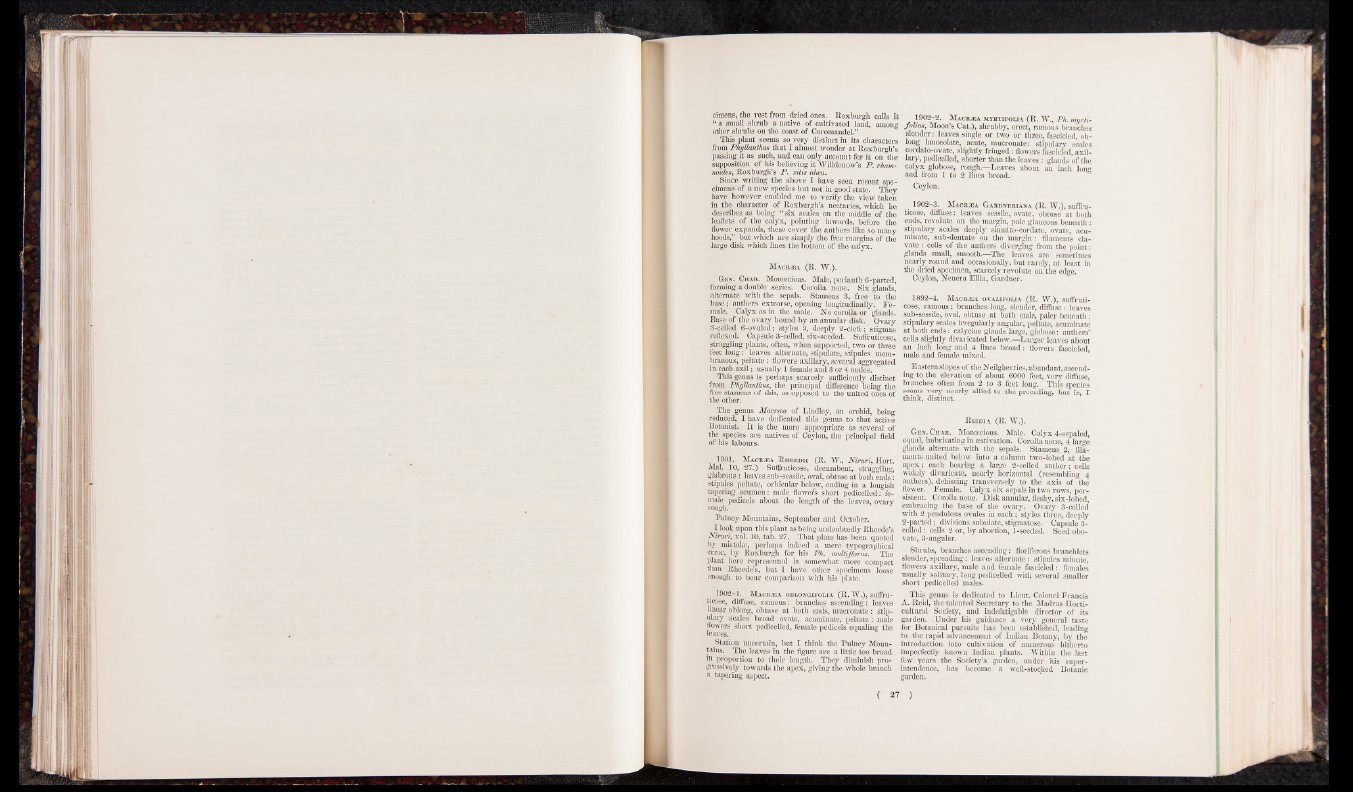
cimens, the rest from -dried ones. Roxburgh calls it
“ a small shrub a native of cultivated land, among
other shrubs on the coast of Coromandel.”
This plant seems so very distinct in its characters
from Phyllanthus that I almost wonder at Roxburgh’s
passing it as such, and can only account for it on the
supposition of his believing it Willdenow’s P . rJiam-
noides, Roxburgh’s P . vitis idcea.
Since writing the above I have seen recent specimens
of a new species but not in good state. They
have however enabled me to verify the view taken
in the character of Roxburgh’s nectaries, which he
describes as being “ six scales on the middle of the
leaflets of the calyx, pointing inwards, before the
flower expands, these cover the anthers like so many
hoods,” but which are simply the free margins of the
large disk which lines the bottom of the calyx.
Macr^ a (R. W.).
Gen. Char. Monoecious. Male, perianth 6-parted,
forming a double" series. Corolla none. Six glands,
alternate with the sepals. Stamens 3, free to the
base; anthers extrorse, opening longitudinally. Female.
Calyx as in the male. ISTo corolla or glands.
Base of the ovary bound by an annular disk. Ovary
3-celled 6-ovuled; styles 3, deeply 2-cleft; stigmas
reflexed. Capsule 3-celled, six-seeded. Suffruticose,
straggling plants, often, when supported, two or three
feet long: leaves alternate, stipulate, stipules membranous,
peltate : flowers axillary, several aggregated
in each a x il; usually 1 female and 3 or 4 males.
This genus is perhaps scarcely sufficiently distinct
from Phyllanthus, the principal difference being the
free stamens of this, as opposed to the united ones of
the other.
The genus Macrata of Lindley, an orchid, being
reduced, I have dedicated this genus to that active
Botanist. I t is the more appropriate as several of
the species are natives of Ceylon, the principal field
of his labours.
1901. Macr.zba Rheedh (R. W., Niruri, Hort.
Mai. 10, 27.) Suffruticose, decumbent, straggling,
glabrous : leaves sub-sessile, oval, obtuse at both ends:
stipules peltate, orbicular below, ending in a longish
tapering acumen: male flowers short pedicelled: female
pedicels about the length of the leaves, ovarv
rough. ' - J
Pulney Mountains, September and October.
I look upon this plant as being undoubtedly Rheede’s
Niruri, vol. 10, tab. 27. That plate has been quoted
by mistake, perhaps indeed a mere typographical
error, by Roxburgh for his Ph. multiflorus. The
plant here represented is somewhat more compact
than Rheede’s, but I have other specimens loose
enough to bear comparison with his plate.
1902-1. Macrzea oblongifolia (R. W .), suffru-
ticose, diffuse, ramous: branches ascending: leaves
linear oblong, obtuse at both ends, mucronate: stipulary
scales broad ovate, acuminate, peltate: male
flowers short pedicelled, female pedicels equaling the
leaves.
Station uncertain, but I think the Pulney Mountains.
The leaves in the figure are a little too broad
111 proportion to their length. They diminish progressively
towards the apex, giving the whole branch
a tapering aspect.
1902-2. Macrsba mtrtifolia (R. W., Ph. myrti-
folius, Moon’s Cat.), shrubby, erect, ramous branches
slender: leaves single or two or three, fascicled, oblong
lanceolate, acute, mucronate: stipulary scales
cordato-ovate, slightly fringed: flowers fascicled, axillary,
pedicelled, shorter than the leaves : glands of the
calyx globose, rough.—Leaves about an inch long
and from 1 to 2 lines broad.
Ceylon,
1902-3. Macrzea Gardneriana (R. W .), suffruticose,
diffuse: leaves sessile, ovate, obtuse at both
ends, revolute on the margin, pale glaucous beneath :
stipulary scales deeply sinuate-cordate, ovate, acuminate,
sub-dentate on the margin: filaments cla-
v a te : cells of the anthers diverging from the point :
glands small, smooth.—The leaves are sometimes
nearly round and occasionally, but rarely, at least in
the dried specimen, scarcely revolute on the edge.
Ceylon, FTeuera Ellia, Gardner.
1892-4. Macrzea ovalifolia (R. W.), suffruticose,
ramous; branches long, slender, diffuse: leaves
sub-sessile, oval, obtuse at both ends, paler beneath:
stipulary scales irregularly angular, peltate, acuminate
at both ends: calycine glands large, globose: anthers’
cells slightly divaricated below.—Larger leaves about
an inch long and 4 lines broad: flowers fascicled,
male and female mixed.
Eastern slopes of the Neilgherries, abundant, ascending
to the elevation of about 6000 feet, very diffuse,
branches often from 2 to 3 feet long. This species
seems very nearly allied to the preceding, but is, I
think, distinct.
R eidia (R. W.).
Gen. Char. Monoecious. Male. Calyx 4-sepaled,
equal, imbricating in «estivation. Corolla none, 4 large
glands alternate with the sepals. Stamens 2, filaments
united below into a column two-lobed at the
apex; each bearing a large 2-celled anther; cells
widely divaricate, nearly horizontal (resembling 4
anthers), dehiscing transversely to the axis of the
flower. Female. Calyx six sepals in two rows, persistent.
Corolla none. Disk annular, fleshy, six-lobed,
embracing the base of the ovary. Ovary 3-celled
with 2 pendulous ovules in each; styles three, deeply
2-parted; divisions subulate, stigmatose. Capsule 3-
celled: cells 2 or, by abortion, 1-seeded. Seed obo-
vate, 3-angular.
Shrubs, branches ascending: floriferous branchlets
slender, spi'eading: leaves alternate: stipules minute,
flowers axillary, male and female fascicled: females
usually solitary, long pedicelled with several smaller
short pedicelled males.
This genus is dedicated to Lieut. Colonel Francis
A.'R eid, the talented Secretary to the Madras Horticultural
Society, and indefatigable director of its
garden. Under his guidance a very general taste
for Botanical pursuits has been established, leading
to the rapid advancement of Indian Botany, by the
introduction into cultivation of numerous hitherto
imperfectly known Indian plants. Within the last
few years the Society’s garden, under his superintendence,
has become a well-stocked Botanic
garden.